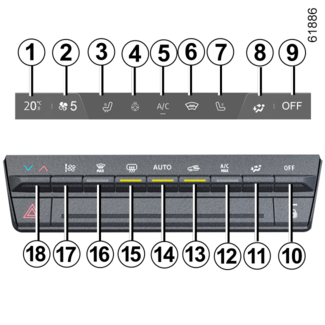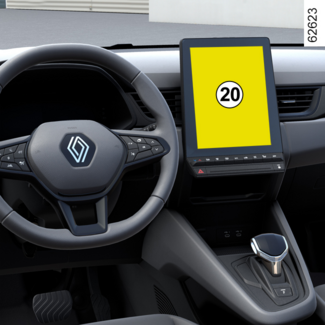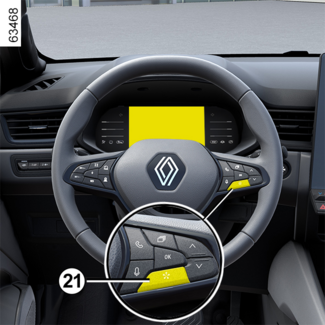Back to the list



Automatic climate control
Automatic climate control
The controls

- 1.
- Heating temperature indicator.
- 2.
- Ventilation speed indicator.
- 3.
- Driver's heated seat activation control.
- 4.
- Heated steering wheel activation control.
- 5.
- Air-conditioning activation control.
- 6.
- Heated windscreen activation control.
- 7.
- Passenger's heated seat activation control.
- 8.
- Passenger compartment air distribution indicator.
- 9.
- System OFF stop indicator light.
- 10.
- System OFF stop control.
- 11.
- Passenger compartment air distribution adjustment.
- 12.
- Activation control for the "A/C MAX" function.
- 13.
- Air recirculation.
- 14.
- Air-conditioning activation control in AUTO mode.
- 15.
- De-icing/demisting of the rear screen and, depending on the vehicle, the rear view mirrors.
- 16.
- "Clear View" function.
- 17.
- Adjusting the ventilation speed and stopping the system.
- 18.
- Adjusting the air temperature.
Operation
Activating the system
When the vehicle is started, the system returns to the last programme used.
The system is also functional when parked.
Press the control 14 to activate the system or set the control 17 to the desired ventilation speed.
Stopping the system
Press control 17 "OFF".
Switching the air conditioning on or off
In automatic mode, the system manages activation of the air conditioning. You will
still be able to activate or deactivate the system by pressing the control 5.
Automatic mode
The automatic climate control system guarantees comfort in the passenger compartment
and good visibility (except in the event of extreme conditions), while optimising
fuel consumption.
The system controls the ventilation speed, air distribution, air recirculation, and
starting and stopping the air conditioning and air temperature.
This mode consists of a choice of three programmes:
AUTO: optimises the selected comfort level according to exterior conditions. Press the
button 14.
SOFT: enables the desired temperature level to be obtained more smoothly and silently.
Press button 14 then press downwards again to activate SOFT mode.
FAST: increases the air flow in the passenger compartment. This mode is recommended in
particular to optimise comfort in the rear seats. Press button 14 then press upwards again to activate FAST mode.
When the air conditioning starts in automatic mode, the system returns to the last
programme used.
Tip
Any action on a button other than the AUTO button deactivates automatic mode.
Adjusting the distribution of air in the passenger compartment
Press 11 one or more times to select the air distribution. The air distribution selected 8 is displayed on the multimedia screen. The positions are in the following order:
- All the air is then directed to the windscreen and front side window demisting vents.
- The air flow is distributed between front side window demisting vents, the windscreen demisting vents and the footwells.
- The air flow is distributed between the front side window demisting vents, the windscreen demisting vents, the dashboard air vents and the footwells.
- The air flow is mainly directed to the dashboard air vents.
- The air flow is directed towards the dashboard vents and towards the footwells.
- The air flow is directed mainly towards the footwells.
Adjusting the air temperature
Press or raise control 18 to adjust the temperature displayed on the indicator light 1.
Adjusting the ventilation fan speed
In automatic mode, the system uses the most suitable amount of air to reach and maintain
the desired comfort level.
You will still be able to adjust the ventilation speed by pressing the control 17 to increase or reduce the ventilation speed.
"Clear View" function
Press the button 16 and the built-in warning light comes on.
This function quickly de-mists the windscreen, rear screen, front side windows and
door mirrors (depending on the vehicle). It automatically activates the air conditioning
and rear screen de-icing functions.
To exit this function, press button 14 or 16.
Rear screen de-icing and demisting
Press the button 15 and the built-in warning light comes on. This function enables rapid demisting or
de-icing of the rear screen and de-icing of the rear view mirrors (on equipped vehicles).
To exit this function, press button 15 again. Demisting automatically stops.
"A/C MAX" function
The "A/C MAX" function enables the user to feel the maximum power of their air conditioning system
without any constraint or compromise related to the acoustics and the feeling of the
air being too cold on the hands and face.
This function involves automatic modifications:
- temperature programmed to fully cold;
- distribution of air to the occupants;
- air flow at its maximum power;
- activation of the air conditioning;
- air recirculation.
Press the button 12 to activate the function. Deactivate ECO mode for best performance.
Air recirculation (isolation of the passenger compartment)
This function is managed automatically, but you can also activate it manually. In
this case the operation is confirmed by a warning light built into the button 13.
Tip
Demisting/de-icing will still take priority over the air recirculation.
Manual use
Press the button 13 and the built-in warning light comes on.
Prolonged use of this position may lead to odours, caused by non-renewal of air, and
the formation of condensation on the windows.
We therefore advise you to return to automatic mode as soon as air recirculation is
no longer needed, by pressing button 13.
ECO mode


From the MULTI-SENSE menu, accessible from the multimedia screen 20 or by pressing the switch 19, you can activate ECO mode, which affects the heating level and reduces the vehicle's fuel consumption.
An ECO warning light located under the temperature display on the multimedia screen 20 informs you that ECO mode is activated.
"Favourites" function

Depending on the vehicle, by pressing the steering wheel control 21 you can activate the following functions according to the stored user settings that
you have previously defined:
- heated steering wheel;
- heated seats;
- heated rear screen;
- heated rear view mirrors.
For more information on programming this function, please refer to the multimedia
instructions.
